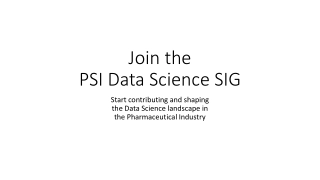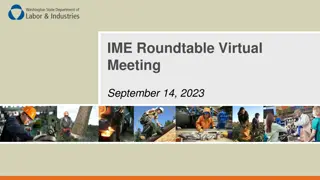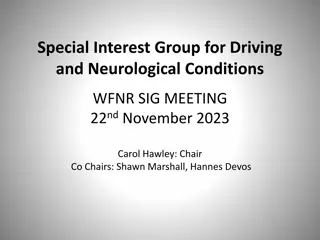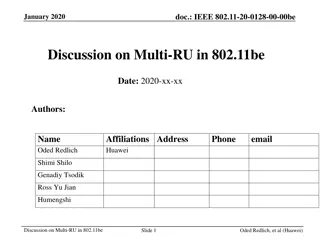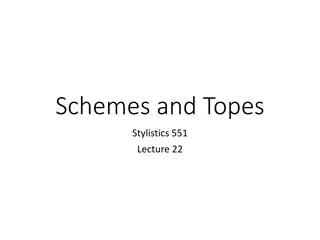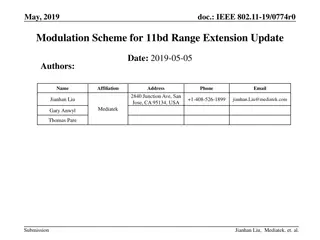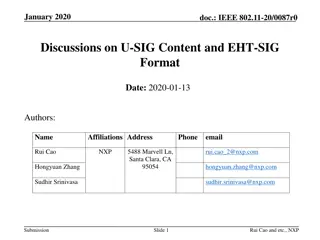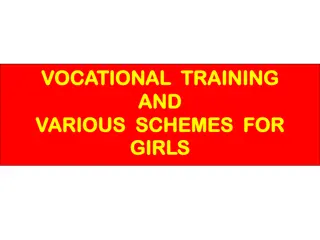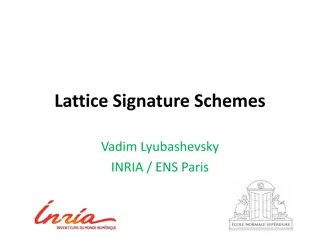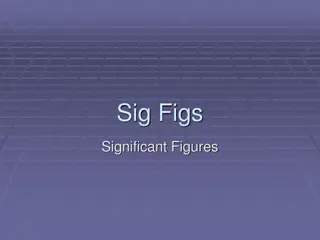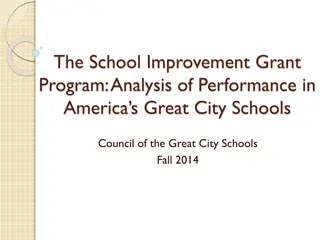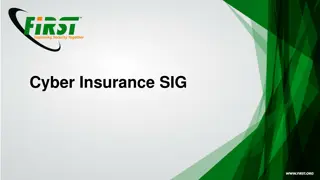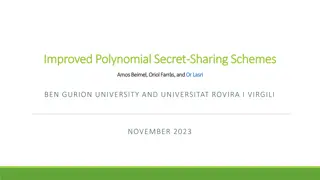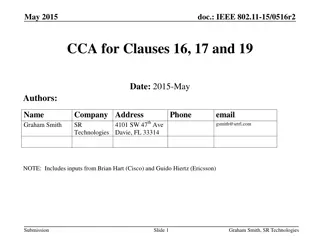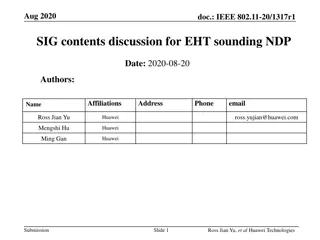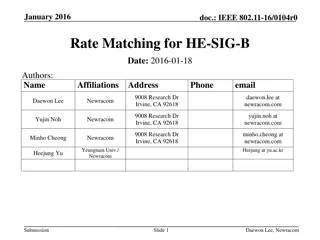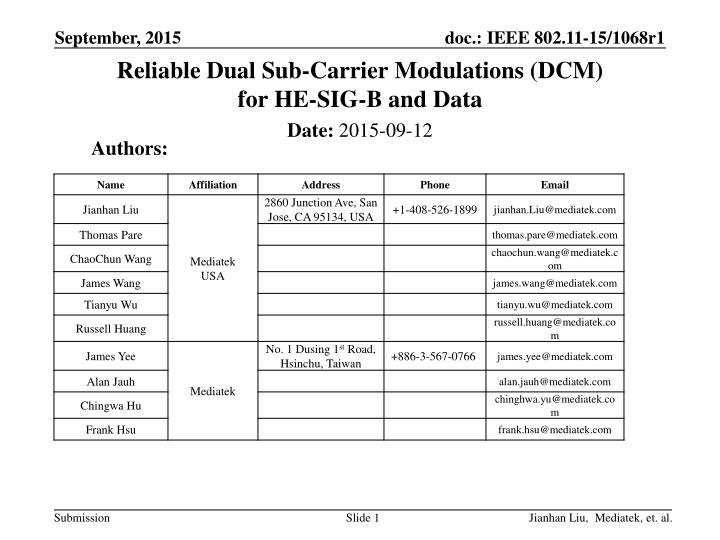
Reliable Dual Sub-Carrier Modulations for HE-SIG-B and Data Transmission
Explore the concept of Reliable Dual Sub-Carrier Modulations (DCM) for enhancing HE-SIG-B and data transmission in IEEE 802.11-15/1068r1. This document, dated September 2015, features a collaboration of authors from various affiliations discussing advanced modulation techniques. Key contributors include Mediatek and Huawei. Discover the innovative strategies proposed by industry experts to improve signal reliability and data integrity in wireless communication.
Download Presentation

Please find below an Image/Link to download the presentation.
The content on the website is provided AS IS for your information and personal use only. It may not be sold, licensed, or shared on other websites without obtaining consent from the author. If you encounter any issues during the download, it is possible that the publisher has removed the file from their server.
You are allowed to download the files provided on this website for personal or commercial use, subject to the condition that they are used lawfully. All files are the property of their respective owners.
The content on the website is provided AS IS for your information and personal use only. It may not be sold, licensed, or shared on other websites without obtaining consent from the author.
E N D
Presentation Transcript
September, 2015 doc.: IEEE 802.11-15/1068r1 Reliable Dual Sub-Carrier Modulations (DCM) for HE-SIG-B and Data Date: 2015-09-12 Authors: Name Affiliation Address Phone Email 2860 Junction Ave, San Jose, CA 95134, USA Jianhan Liu +1-408-526-1899 jianhan.Liu@mediatek.com Thomas Pare thomas.pare@mediatek.com chaochun.wang@mediatek.c om james.wang@mediatek.com ChaoChun Wang Mediatek USA James Wang Tianyu Wu tianyu.wu@mediatek.com russell.huang@mediatek.co m Russell Huang No. 1 Dusing 1st Road, Hsinchu, Taiwan James Yee +886-3-567-0766 james.yee@mediatek.com Alan Jauh alan.jauh@mediatek.com chinghwa.yu@mediatek.co m frank.hsu@mediatek.com Mediatek Chingwa Hu Frank Hsu Submission Slide 1 Jianhan Liu, Mediatek, et. al.
September, 2015 doc.: IEEE 802.11-15/1068r1 Authors (continued) Name Affiliation Address Phone Email Peter Loc peterloc@iwirelesstech.com F1-17, Huawei Base, Bantian, Shenzhen 5B-N8, No.2222 Xinjinqiao Road, Pudong, Shanghai F1-17, Huawei Base, Bantian, Shenzhen 5B-N8, No.2222 Xinjinqiao Road, Pudong, Shanghai 5B-N8, No.2222 Xinjinqiao Road, Pudong, Shanghai 10180 Telesis Court, Suite 365, San Diego, CA 92121 NA 303 Terry Fox, Suite 400 Kanata, Ottawa, Canada F1-17, Huawei Base, Bantian, Shenzhen 10180 Telesis Court, Suite 365, San Diego, CA 92121 NA F1-17, Huawei Base, Bantian, SHenzhen 303 Terry Fox, Suite 400 Kanata, Ottawa, Canada 5B-N8, No.2222 Xinjinqiao Road, Pudong, Shanghai Le Liu liule@huawei.com +86-18601656691 Jun (Rossi) Luo jun.l@huawei.com Yi Luo Roy.luoyi@huawei.com +86-18665891036 Yingpei Lin linyingpei@huawei.com Jiyong Pang pangjiyong@huawei.com Zhigang Rong zhigang.rong@huawei.com Huawei Rob Sun Rob.Sun@huawei.com David X. Yang david.yangxun@huawei.com Yunsong Yang yangyunsong@huawei.com Zhou Lan Lanzhou1@huawei.com +86-18565826350 Junghoon Suh Junghoon.Suh@huawei.com Jiayin Zhang zhangjiayin@huawei.com +86-18601656691 Submission Jianhan Liu, Mediatek, et. al. Slide 2
September, 2015 Authors (continued) doc.: IEEE 802.11-15/1068r1 Name Affiliation Address Phone Email Straatweg 66-S Breukelen, 3621 BR Netherlands 5775 Morehouse Dr. San Diego, CA, USA 5775 Morehouse Dr. San Diego, CA, USA 5775 Morehouse Dr. San Diego, CA, USA 1700 Technology Drive San Jose, CA 95110, USA 5775 Morehouse Dr. San Diego, CA, USA 5775 Morehouse Dr. San Diego, CA, USA 5775 Morehouse Dr. San Diego, CA, USA Straatweg 66-S Breukelen, 3621 BR Netherlands Straatweg 66-S Breukelen, 3621 BR Netherlands 1700 Technology Drive San Jose, CA 95110, USA 5775 Morehouse Dr. San Diego, CA, USA 5775 Morehouse Dr. San Diego, CA, USA 1700 Technology Drive San Jose, CA 95110, USA 1700 Technology Drive San Jose, CA 95110, USA 1700 Technology Drive San Jose, CA 95110, USA Albert Van Zelst allert@qti.qualcomm.com Alfred Asterjadhi aasterja@qti.qualcomm.com Arjun Bharadwaj arjunb@qti.qualcomm.com Bin Tian btian@qti.qualcomm.com Carlos Aldana caldana@qca.qualcomm.com George Cherian gcherian@qti.qualcomm.com Gwendolyn Barriac gbarriac@qti.qualcomm.com Hemanth Sampath hsampath@qti.qualcomm.com Qualcomm Menzo Wentink mwentink@qti.qualcomm.com Richard Van Nee rvannee@qti.qualcomm.com Rolf De Vegt rolfv@qca.qualcomm.com Sameer Vermani svverman@qti.qualcomm.com Simone Merlin smerlin@qti.qualcomm.com Tevfik Yucek tyucek@qca.qualcomm.com VK Jones vkjones@qca.qualcomm.com Youhan Kim youhank@qca.qualcomm.com Submission Jianhan Liu, Mediatek, et. al. Slide 3
September, 2015 Authors (continued) doc.: IEEE 802.11-15/1068r1 Name Affiliation Address Phone Email Robert Stacey robert.stacey@intel.com Eldad Perahia eldad.perahia@intel.com Shahrnaz Azizi shahrnaz.azizi@intel.com 2111 NE 25th Ave, Hillsboro OR 97124, USA Po-Kai Huang po-kai.huang@intel.com +1-503-724-893 Qinghua Li Intel quinghua.li@intel.com Xiaogang Chen xiaogang.c.chen@intel.com Chitto Ghosh chittabrata.ghosh@intel.com Laurent cariou laurent.cariou@intel.com Rongzhen Yang rongzhen.yang@intel.com Ron Porat rporat@broadcom.com Matthew Fischer Sriram Venkateswaran Andrew Blanksby Matthias Korb mfischer@broadcom.com Broadcom Tu Nguyen Vinko Erceg Submission Jianhan Liu, Mediatek, et. al. Slide 4
September, 2015 doc.: IEEE 802.11-15/1068r1 Authors (continued): Name Affiliation Address Phone Email Hongyuan Zhang hongyuan@marvell.com Yakun Sun yakunsun@marvell.com Lei Wang Leileiw@marvell.com Liwen Chu liwenchu@marvell.com Jinjing Jiang jinjing@marvell.com Yan Zhang yzhang@marvell.com 5488 Marvell Lane, Santa Clara, CA, 95054 Rui Cao Marvell 408-222-2500 ruicao@marvell.com Bo Yu jiehuang@marvell.com Sudhir Srinivasa sudhirs@marvell.com Saga Tamhane sagar@marvell.com Mao Yu my@marvel..com Edward Au edwardau@marvell.com Hui-Ling Lou Joonsuk Kim hlou@marvell.com joonsuk@apple.com mujtaba@apple.com Aon Mujtaba Guoqing Li Apple guoqing_li@apple.com Eric Wong ericwong@apple.com Chris Hartman chartman@apple.com Submission Slide 5 Jianhan Liu, Mediatek, et. al.
September, 2015 Authors (continued) doc.: IEEE 802.11-15/1068r1 Name Affiliation Address Phone Email Hyeyoung Choi hy0117.choi@lge.com Kiseon Ryu kiseon.ryu@lge.com Jinyoung Chun jiny.chun@lge.com Jinsoo Choi js.choi@lge.com 19, Yangjae-daero 11gil, Seocho-gu, Seoul 137- 130, Korea Jeongki Kim jeongki.kim@lge.com LG Electronics Giwon Park giwon.park@lge.com Dongguk Lim dongguk.lim@lge.com Suhwook Kim suhwook.kim@lge.com Eunsung Park esung.park@lge.com HanGyu Cho hg.cho@lge.com Thomas Derham Orange thomas.derham@orange.com #9 Wuxingduan, Xifeng Rd., Xi'an, China Bo Sun sun.bo1@zte.com.cn Kaiying Lv Yonggang Fang Ke Yao Weimin Xing Brian Hart Pooya Monajemi lv.kaiying@zte.com.cn yfang@ztetx.com yao.ke5@zte.com.cn xing.weimin@zte.com.cn brianh@cisco.com pmonajem@cisco.com ZTE 170 W Tasman Dr, San Jose, CA 95134 Cisco Systems Submission Jianhan Liu, Mediatek, et. al. Slide 6
September, 2015 Authors (continued) doc.: IEEE 802.11-15/1068r1 Name Affiliation Address Innovation Park, Cambridge CB4 0DS (U.K.) Maetan 3-dong; Yongtong-Gu Suwon; South Korea 1301, E. Lookout Dr, Richardson TX 75070 Innovation Park, Cambridge CB4 0DS (U.K.) 1301, E. Lookout Dr, Richardson TX 75070 Maetan 3-dong; Yongtong-Gu Suwon; South Korea Phone Email Fei Tong f.tong@samsung.com +44 1223 434633 Hyunjeong Kang hyunjeong.kang@samsung.com +82-31-279-9028 Kaushik Josiam k.josiam@samsung.com (972) 761 7437 Samsung Mark Rison m.rison@samsung.com +44 1223 434600 Rakesh Taori rakesh.taori@samsung.com (972) 761 7470 Sanghyun Chang s29.chang@samsung.com +82-10-8864-1751 Yasushi Takatori takatori.yasushi@lab.ntt.co.jp Yasuhiko Inoue inoue.yasuhiko@lab.ntt.co.jp 1-1 Hikari-no-oka, Yokosuka, Kanagawa 239-0847 Japan Yusuke Asai NTT asai.yusuke@lab.ntt.co.jp Koichi Ishihara ishihara.koichi@lab.ntt.co.jp Akira Kishida kishida.akira@lab.ntt.co.jp 3-6, Hikarinooka, Yokosuka- shi, Kanagawa, 239-8536, Japan Akira Yamada yamadaakira@nttdocomo.com watanabe@docomoinnovations. com hpapadopoulos@docomoinnova tions.com Fujio Watanabe NTT DOCOMO 3240 Hillview Ave, Palo Alto, CA 94304 Haralabos Papadopoulos Submission Jianhan Liu, Mediatek, et. al. Slide 7
doc.: IEEE 802.11-15/1068r1 Authors (continued) Kazuyuki.Sakoda@am.son y.com Kazuyuki Sakoda YusukeC.Tanaka@jp.sony.c om Yusuke Tanaka Sony Eisuke.Sakai@jp.sony.com Eisuke Sakai Electronics Yuichi.Morioka@jp.sony.co m Yuichi Morioka Masahito.Mori@jp.sony.co m Masahito Mori Submission
doc.: IEEE 802.11-15/1068r1 HE-SIG-B and Data HE-SIG-B Performance of HE-SIG-B is encoded using 1x symbol duration. So its performance is worse than data symbol with 4x symbol duration when used the same MCS. Under dense deployment, robustness with narrow-band interferences is also important to HE WLAN HE-Data Enhance the PER performance of Data portion can extend range for outdoor scenarios Under dense deployment, robustness with narrow-band interferences is also important to HE WLAN Submission Slide 9 Jianhan Liu, Mediatek, et al
doc.: IEEE 802.11-15/1068r1 Robustness to interferences Narrow band interferences In 11ax, a STA can transmit one RU (about 2 MHz bandwidth) in Uplink OFDMA. Compared to its 20MHz preamble, the power density of its data portion is 9dB higher than its preamble. Therefore one STA can experience 9dB higher interferences on subcarriers in a particular narrow band than other subcarriers. DCM is a perfect solution to deal with such narrow band interferences. Note that narrow band interferences are intrinsic in 11ax. Submission Slide 10 Jianhan Liu, Mediatek, et al
doc.: IEEE 802.11-15/1068r1 Introduce Dual Sub-carrier Modulation Dual Sub-carrier Modulation (DCM) modulates the same information on a pair of sub-carrier n and sub-carrier m. Subcarrier n and sub-carrier m are typically separated far apart in frequency. Pros Data rate can be kept same as modulations used in IEEE 802.11ac. Diversity gain can be obtained by using DCM. More robust when sub-band interferences are present. Significant improvement on PER for the same data rate Range extension Better user experiences Submission Jianhan Liu, Mediatek, et al Slide 11
doc.: IEEE 802.11-15/1068r1 Dual Sub-carrier Modulation The encoding (TX side) and decoding (RX side) of DCM is really simple TX: just change the modulation with another mapping RX: just simple calculations to combine the LLR For example, for QPSK DCM:TX just mapping 2 bits with QPSK and Rotated QPSK; RX just add two LLRs 11n Bit interleaver DCM IFFT Subcarrier K Subcarrier K+N/2 Submission Jianhan Liu, Mediatek, et al Slide 12
doc.: IEEE 802.11-15/1068r1 Dual Sub-carrier Modulation Mappings For BPSK and can be obtained by mapping 1 encoded bit using BPSK and SBPSK respectively. For QPSK and can be modulated by mapping 2 encoded bits using QPSK and SQPSK (or other rotated QPSK schemes) respectively. For 16 QAM n s s m n s s m B B 0 0 = , 1 0 b B B i 1 1 = = = and where 1 2 2 2 1 2 sn j j sm j j B i + = , 1 1 B B b 2 2 i B B 3 3 Applying Sub-carrier Modulation to modulations higher than 16QAM should not be supported Dual Sub-carrier Modulation may reduce data rate for higher modulation to achieve higher performance. Submission Jianhan Liu, Mediatek, et al Slide 13
September, 2015 doc.: IEEE 802.11-15/1068r1 DCM Indication Schemes In HE-SIGA, we introduce 1-bit DCM indication as follows. For SU, DCM bit indicates the modulation of payload DCM bit in HE-SIGA MCS of Payload Modulation Schemes of Payload Indication in HE-SIG-A 1 x MCS x with DCM 0 x MCS x For SU, DCM bit indicates the modulation of HE-SIGB DCM bit in HE-SIGA HE-SIG-B MCS HE-SIG-B Modulation Schemes Indication in HE-SIG-A 1 x MCS x with DCM 0 x MCS x The indication of DCM for payload in MU format is TBD. Submission Slide 14 Jianhan Liu, Mediatek, et. al.
September, 2015 doc.: IEEE 802.11-15/1068r1 Simulation Settings for Data Channels: Channel type D and UMi channel 4x Symbol 1.6us CP Packet length: 2048 bytes Time domain simulation Real channel estimation With CPE tracking Submission Slide 15 Jianhan Liu, Mediatek, et. al.
September, 2015 doc.: IEEE 802.11-15/1068r1 UMi NLOS Channel (4x symbol length, BCC) PER comparison for DCM modulations, 20MHz,Ch Umi,4x symbol length 0 10 Performance Gain: 1.5dB gain for MCS0 and MCS2 at 1% PER Error floor is also reduced BPSK 1/2 DCM QPSK 1/2 QPSK 1/2 DCM 16QAM 1/2 QPSK 3/4 DCM 16QAM 3/4 -1 10 It also says: -2 PER 10 Gain is also significant for 4x symbol. The payload in this simulation is just one 4x OFDM symbol. -3 10 -4 10 0 5 10 15 20 25 SNR Submission Slide 16 Jianhan Liu, Mediatek, et. al.
September, 2015 doc.: IEEE 802.11-15/1068r1 Simulations with Narrowband Interferences Setting: Narrowband interference that is 9dB higher than noise floor on one 26 tone RU. PER comparison for DCM modulations, 20MHz,Ch Umi,4x,Interference on one RU 0 10 Performance Gain: 4dB gain for MCS0 at 1% PER 2dB gain for MCS2 at 1% PER Even for MCS 1, there is about 0.6dB Gain Error floor is also reduced -1 10 -2 PER 10 It also says: When there is narrow band OBSS interferences, DCM provide a huge gain. BPSK 1/2 DCM QPSK 1/2 QPSK 1/2 DCM 16QAM 1/2 QPSK 3/4 DCM 16QAM 3/4 -3 10 -4 10 0 5 10 15 20 25 SNR Submission Slide 17 Jianhan Liu, Mediatek, et. al.
September, 2015 doc.: IEEE 802.11-15/1068r1 Performance of DCM for LDPC 4x symbol length, 1.6us CP, 256 bytes packet, LDPC under UMi NLOS Channel model PER comparison for DCM modulations, LDPC, 4x symbol 0 10 For MCS 0 with DCM: Around 1.7dB gain at 1% PER; Around 1dB gain at 10% PER; Error floor reduced. For MCS 1 with DCM: Around 0.7dB gain at 10% PER; Error floor is similar. For MCS 2 with DCM: Around 1dB gain at 10% PER; Error floor is reduced. BPSK 1/2 DCM QPSK 1/2 QPSK 1/2 DCM 16QAM 1/2 QPSK 3/4 DCM 16QAM 3/4 -1 10 -2 PER 10 -3 10 -4 10 0 5 10 15 20 25 30 SNR Submission Slide 18 Jianhan Liu, Mediatek, et. al.
September, 2015 doc.: IEEE 802.11-15/1068r1 Simulations with Narrowband Interferences for LDPC With interference 10 dB higher than noise on one 26 tone RU. PER comparison for DCM modulations, 20MHz,Ch Umi,4x,24 bytes 0 Performance Gain: 4dB gain for MCS0 at 1% PER 2dB gain for MCS2 at 1% PER Even for MCS 1, there is about 0.5dB Gain 10 BPSK 1/2 DCM QPSK 1/2 QPSK 1/2 DCM 16QAM 1/2 QPSK 3/4 DCM 16QAM 3/4 -1 10 -2 PER 10 -3 10 -4 10 0 5 10 15 20 25 30 SNR Submission Slide 19 Jianhan Liu, Mediatek, et. al.
September, 2015 doc.: IEEE 802.11-15/1068r1 Simulation Settings for HE-SIG-B 1x symbol length Assume 24-byte information bits for HE-SIG-B Channels: UMi channel 0.8us CP Time domain simulation With real channel estimation With CPE tracking Submission Slide 20 Jianhan Liu, Mediatek, et. al.
September, 2015 doc.: IEEE 802.11-15/1068r1 UMi NLOS Channel (1x symbol length) PER comparison for DCM modulations, 20MHz,Ch Umi,1x,24 bytes 0 10 BPSK 1/2 DCM QPSK 1/2 QPSK 3/4 DCM 16QAM 3/4 Performance Gain About 0.7dB gain over the same rate MCS Error floor is also reduced -1 10 PER -2 10 -3 10 -5 0 5 10 15 20 25 30 SNR Submission Slide 21 Jianhan Liu, Mediatek, et. al.
September, 2015 doc.: IEEE 802.11-15/1068r1 UMi NLOS Channel (1x symbol length) with perfect channel estimation PER comparison for DCM modulations 0 10 BPSK 1/2 DCM QPSK 1/2 QPSK 1/2 DCM 16QAM 1/2 QPSK 3/4 DCM 16QAM 3/4 Performance Gain 1.7dB gain over BPSK, rate code at 1% PER 2dB gain and error floor significantly reduced for QPSK, rate code -1 10 PER It also says: If we can improve the channel estimation, the gain can be much larger. Note that we indeed can improve the channel estimation by using RL-SIG. -2 10 -3 10 -5 0 5 10 15 20 25 SNR Submission Slide 22 Jianhan Liu, Mediatek, et. al.
September, 2015 doc.: IEEE 802.11-15/1068r1 Advantages of using Dual sub-carrier modulation No change for 11n/ac bit interleaver and other TX and RX blocks. No latency added. (Modulation within one OFDM symbol) Negligible complexity at modulator and demodulator For modulator, just modulate the subcarriers in the upper band and the subcarriers in lower band the similar way. For demodulator, LLR calculation just needs the combination of two subcarriers PER performance improved more than 2dB gain for MCS0 and MCS 2 in 4x symbol. The performance gain is significant. (Note LDPC just bring 1.5dB to 2dB gain over BCC.) Error floor is reduced for outdoor channels. More robustness to sub-band interferences. Provide a very good data rate vs. PER tradeoff between QPSK rate code and 16QAM rate code. Submission Slide 23 Jianhan Liu, Mediatek, et. al.
September, 2015 doc.: IEEE 802.11-15/1068r1 Straw Poll #1 Do you agree to add dual sub-carrier modulations (DCM) as optional modulation schemes for HE-SIGB and Payload to 11ax SFD? Dual sub-carrier modulation (DCM) are only applied to BPSK, QPSK and 16QAM modulations. Y N A Submission Slide 24 Jianhan Liu, Mediatek, et. al.
September, 2015 doc.: IEEE 802.11-15/1068r1 Straw Poll # 2 Do you agree to add one bit DCM indication in HE-SIGA to 11ax SFD? Y N A Submission Slide 25 Jianhan Liu, Mediatek, et. al.

